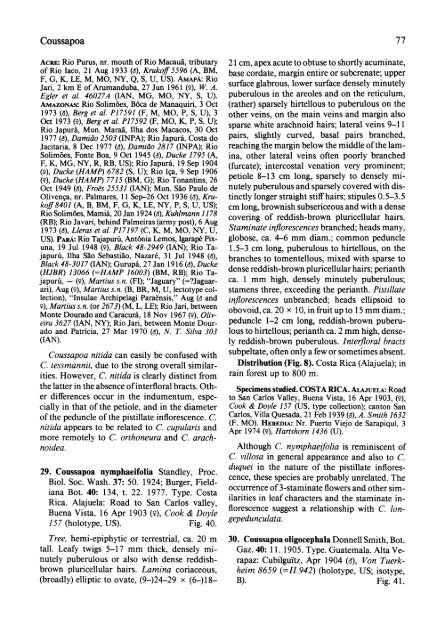Cecropiaceae: Coussapoa and Pourouma, with an ... - CNCFlora
Cecropiaceae: Coussapoa and Pourouma, with an ... - CNCFlora
Cecropiaceae: Coussapoa and Pourouma, with an ... - CNCFlora
Create successful ePaper yourself
Turn your PDF publications into a flip-book with our unique Google optimized e-Paper software.
<strong>Coussapoa</strong><br />
ACRE: Rio Purus, nr. mouth of Rio Macaua, tributary<br />
of Rio Iaco, 21 Aug 1933 (6), Krukoff5596 (A, BM,<br />
F, G, K, LE, M, MO, NY, Q, S, U, US). AMAPA: Rio<br />
Jari, 2 km E of Arum<strong><strong>an</strong>d</strong>uba, 27 Jun 1961 (2), W. A.<br />
Egler et al. 46027A (IAN, MG, MO, NY, S, U).<br />
AMAZONAS: Rio Solim6es, B6ca de M<strong>an</strong>aquiri, 3 Oct<br />
1973 (6), Berg et al. P17591 (F, M, MO, P, S, U), 3<br />
Oct 1973 (2), Berg et al. P17592 (F, MO, K, P, S, U);<br />
Rio Japura, Mun. Maraa, Ilha dos Macacos, 30 Oct<br />
1977 (8), Damiao 2503 (INPA); Rio Japura, Costa do<br />
Jacitaria, 8 Dec 1977 (8), Damido 2817 (INPA); Rio<br />
Solimoes, Fonte Boa, 9 Oct 1945 (6), Ducke 1795 (A,<br />
F, K, MG, NY, R, RB, US); Rio Japura, 19 Sep 1904<br />
(9), Ducke (HAMP) 6782 (S, U); Rio Ia, 9 Sep 1906<br />
(9), Ducke (HAMP) 7715 (BM, G); Rio Ton<strong>an</strong>tins, 26<br />
Oct 1949 (6), Frogs 25531 (IAN); Mun. Sao Paulo de<br />
Olivenca, nr. Palmares, 11 Sep-26 Oct 1936 (6), Krukoff<br />
8401 (A, B, BM, F, G, K, LE, NY, P, S, U, US);<br />
Rio Solimoes, Mamia, 20 J<strong>an</strong> 1924 (8), Kuhlm<strong>an</strong>n 1178<br />
(RB); Rio Javari, behind Palmeiras (army post), 6 Aug<br />
1973 (8), Lleras et al. P17197 (C, K, M, MO, NY, U,<br />
US). PARA: Rio Tajapurir, Ant6nia Lemos, Igarape Pixuna,<br />
19 Jul 1948 (2), Black 48-2949 (IAN); Rio Tajapuri,<br />
Ilha Sao Sebastiao, Nazar6, 31 Jul 1948 (6),<br />
Black 48-3017 (IAN); Gurupa, 27 J<strong>an</strong> 1916 (6), Ducke<br />
(HJBR) 13066 (=HAMP 16003) (BM, RB); Rio Tajapurfi,<br />
- 21 cm, apex acute to obtuse to shortly acuminate,<br />
base cordate, margin entire or subcrenate; upper<br />
surface glabrous, lower surface densely minutely<br />
puberulous in the areoles <strong><strong>an</strong>d</strong> on the reticulum,<br />
(rather) sparsely hirtellous to puberulous on the<br />
other veins, on the main veins <strong><strong>an</strong>d</strong> margin also<br />
sparse white arachnoid hairs; lateral veins 9-11<br />
pairs, slightly curved, basal pairs br<strong>an</strong>ched,<br />
reaching the margin below the middle of the lamina,<br />
other lateral veins often poorly br<strong>an</strong>ched<br />
(furcate); intercostal venation very prominent;<br />
petiole 8-13 cm long, sparsely to densely minutely<br />
puberulous <strong><strong>an</strong>d</strong> sparsely covered <strong>with</strong> distinctly<br />
longer straight stiff hairs; stipules 0.5-3.5<br />
cm long, brownish subsericeous <strong><strong>an</strong>d</strong> <strong>with</strong> a dense<br />
covering of reddish-brown pluricellular hairs.<br />
Staminate inflorescences br<strong>an</strong>ched; heads m<strong>an</strong>y,<br />
globose, ca. 4-6 mm diam.; common peduncle<br />
1.5-3 cm long, puberulous to hirtellous, on the<br />
br<strong>an</strong>ches to tomentellous, mixed <strong>with</strong> sparse to<br />
dense reddish-brown pluricellular hairs; peri<strong>an</strong>th<br />
(), Martius s.n. (FI); "Jaguary" (=?Jaguar- ca. 1 mm high, densely minutely puberulous;<br />
ari), Aug (9), Martius s.n. (B, BR, M, U, lectotype col- stamens three, exceeding the peri<strong>an</strong>th. Pistillate<br />
lection), "Insulae Archipelagi Paraensis," Aug (d <strong><strong>an</strong>d</strong> inflorescences unbr<strong>an</strong>ched; heads ellipsoid to<br />
2), Martius s.n. (or 2673) (M, L, LE); Rio Jari, between<br />
Monte Dourado <strong><strong>an</strong>d</strong> Caracura, 18 Nov 1967 (9), Oliv- obovoid, ca. 20 x 10, in fruit up to 15 mm diam.;<br />
eira 3627 (IAN, NY); Rio Jari, between Monte Dour- peduncle 1-2 cm long, reddish-brown puberuado<br />
<strong><strong>an</strong>d</strong> Patricia, 27 Mar 1970 (6), N. T. Silva 303 lous to hirtellous; peri<strong>an</strong>th ca. 2 mm high, dense-<br />
(IAN).<br />
ly reddish-brown puberulous. Interfloral bracts<br />
subpeltate, often only a few or sometimes absent.<br />
Distribution (Fig. 8). Costa Rica (Alajuela); in<br />
rain forest up to 800 m.<br />
<strong>Coussapoa</strong> nitida c<strong>an</strong> easily be confused <strong>with</strong><br />
C. tessm<strong>an</strong>nii, due to the strong overall similar-<br />
ities. However, C. nitida is clearly distinct from<br />
the latter in the absence ofinterfloral bracts. Oth-<br />
er differences occur in the indumentum, espe-<br />
cially in that of the petiole, <strong><strong>an</strong>d</strong> in the diameter<br />
of the peduncle of the pistillate inflorescence. C.<br />
nitida appears to be related to C. cupularis <strong><strong>an</strong>d</strong><br />
more remotely to C. orthoneura <strong><strong>an</strong>d</strong> C. arach-<br />
noidea.<br />
29. <strong>Coussapoa</strong> nymphaeifolia St<strong><strong>an</strong>d</strong>ley, Proc.<br />
Biol. Soc. Wash. 37: 50. 1924; Burger, Field-<br />
i<strong>an</strong>a Bot. 40: 134, t. 22. 1977. Type. Costa<br />
Rica. Alajuela: Road to S<strong>an</strong> Carlos valley,<br />
Buena Vista, 16 Apr 1903 (2), Cook & Doyle<br />
157 (holotype, US). Fig. 40.<br />
Tree, hemi-epiphytic or terrestrial, ca. 20 m<br />
tall. Leafy twigs 5-17 mm thick, densely mi-<br />
nutely puberulous or also <strong>with</strong> dense reddish-<br />
brown pluricellular hairs. Lamina coriaceous,<br />
(broadly) elliptic to ovate, (9-)24-29 x (6-)18-<br />
Specimens studied. COSTA RICA. ALAJUELA: Road<br />
to S<strong>an</strong> Carlos Valley, Buena Vista, 16 Apr 1903, (2),<br />
Cook & Doyle 157 (US, type collection); c<strong>an</strong>ton S<strong>an</strong><br />
Carlos, Villa Quesada, 21 Feb 1939 (8), A. Smith 1632<br />
(F, MO). HEREDIA: Nr. Puerto Viejo de Sarapiqui, 3<br />
Apr 1974 (2), Hartshorn 1436 (U).<br />
77<br />
Although C. nymphaeifolia is reminiscent of<br />
C. villosa in general appear<strong>an</strong>ce <strong><strong>an</strong>d</strong> also to C.<br />
duquei in the nature of the pistillate inflores-<br />
cence, these species are probably unrelated. The<br />
occurrence of 3-staminate flowers <strong><strong>an</strong>d</strong> other sim-<br />
ilarities in leaf characters <strong><strong>an</strong>d</strong> the staminate in-<br />
florescence suggest a relationship <strong>with</strong> C. lon-<br />
gepedunculata.<br />
30. <strong>Coussapoa</strong> oligocephala Donnell Smith, Bot.<br />
Gaz. 40: 11. 1905. Type. Guatemala. Alta Ve-<br />
rapaz: Cubilguitz, Apr 1904 (6), Von Tuerk-<br />
heim 8659 (=11.942) (holotype, US; isotype,<br />
B). Fig. 41.
















